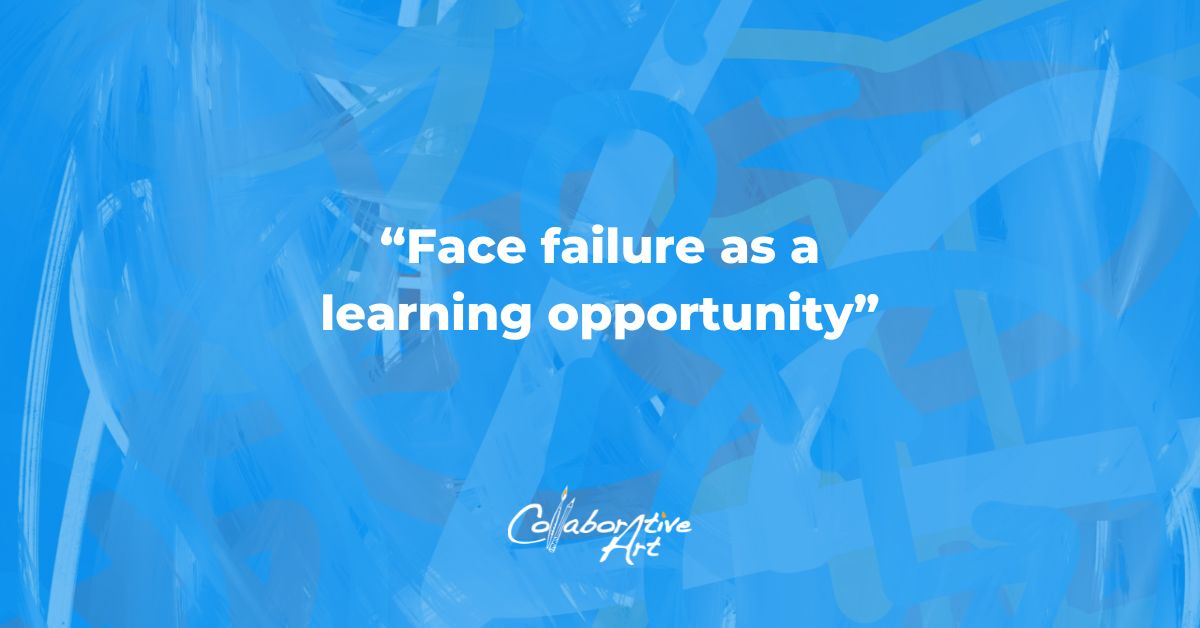Courageous leadership sets high-performing teams and companies apart. But what is courageous leadership? And what does it look like in action?
I’ve always been fascinated by how courage shows up and is reinforced in the creative process through my work as an artist and Collaborative Art® team-building. Creativity - and leadership - require a lot of courage.
In this article, I’ve distilled five characteristics that tie together courage, leadership and art, and practical examples of what it means to be a courageous leader.
A Courageous Leader Is Open and Vulnerable
Courage has little to do with fearlessness; it’s more about leaning into the vulnerability and imperfections of a leader and turning them into strengths. One of the most famous advocates of this idea is the renowned researcher, author and speaker Brené Brown, who catapulted the idea into the wider public’s consciousness through her TEDX talk, The Power of Vulnerability.
For Brown, courageous leaders are open about their struggles, fears, and uncertainties. They don't try to hide their imperfections but acknowledge them as part of their humanity, creating an atmosphere where others can be vulnerable, too.
Courageous leaders don't try to hide their imperfections, she says:
“If you want braver leaders, you must cultivate a culture where people are willing to do hard things, have difficult conversations, fail, recover, and start again”, Brown writes in her article on daring leadership. “There is no courage without vulnerability”.
A Courageous Leader Faces Failure
Vulnerability also means acknowledging the option of failure and facing failure with your head held high if and when it happens. Harvard Business Review shares the story of Fred Keller as an example of facing failure courageously.
Fred Keller had high ambitions for the business he had founded: a manufacturing company called Cascade Engineering. He aimed to not only generate profits but to address society's needs as well.
He set out to launch a programme that hired local unemployed people and integrated them into the company. The first version of the programme failed miserably; the new hires weren’t equipped with the talents needed to succeed - or even stay - in their jobs, and the managers didn’t have the skills and expertise needed to support the new employees either.
However, Keller didn’t get caught up with the traditional definitions of success as an immediate win but faced this failure as information. He kept following his vision, leading to his second attempt failing too!
In courageous hands, “failure” turns into a growth opportunity. A courageous leader is not afraid to make mistakes, admit to making them when needed and try again to get better results.

A Courageous Leader Makes Difficult Decisions When Needed
When Fred Keller followed his vision after his first failed attempts, he embodied another characteristic of a courageous leader: he was willing to make difficult decisions when needed to follow his vision.
When his team repeated the project, they identified and encountered new problems. One of them was the attitudes within the company, which finally led to “letting go of some employees whose attitudes got in the way of their performance”.
“Real leadership isn’t about winning a popularity contest. It’s about doing important work on behalf of others”, resumes the article. In Brené Brown’s words:
“A courageous leader deals with a conflict rather than avoid it."

Courageous Leaders Pull, Don’t Push
Vulnerability, accepting failure and making difficult decisions are all built on the foundation of psychological safety in the team. Another way to approach building a safe environment is through “Push” and “Pull” leadership.
Jack Zenger and Joseph Folkman introduced the concepts. According to their research, two typical leadership behaviours strive to reach the same outcome or results but approach the question from opposite perspectives.
“Push” leaders tend to emphasise the need for results, while “Pull” leaders focus on inspiring and motivating others. Courageous “Pull” leaders don’t focus on imposing their vision on others but create a space where collective wisdom can take root and lead to outcomes that can only be achieved through successful team collaboration.

In the spirit of “Pull” leadership, Brené Brown suggests a simple “Say More” technique: asking follow-up questions and creating the space to share and voice opinions.
To borrow one more idea from the world of performing arts, the improvisation technique of “Yes, and?” (instead of “Yes, but…”) can also be part of courageous leaders’ toolkits. Following up ideas by asking, “Yes, and what could come next?” opens avenues for creative results.
Courageous Leaders Focus on The Process Rather Than The Outcome
Creating space for open exploration can be far from easy; however, leadership often reminds me of the creative process: while you may have an idea of the ideal outcome in mind, creating art is not about controlling the outcome but trusting the process to see what unfolds. This can feel dauntingly scary, but what makes open exploration easier is a strong process.
The concept comes to life in the Collaborative Art® team-building. The participants engage in the prototyping stage, a speed iteration that allows the team to play out many variations before deciding on the final direction.
Participants can trust that the result will be good - even if they can’t tell what it will be yet! In the structured environment of the Collaborative Art® experience, the teams can build the courage to explore the unknown, let go and trust the process and people they work with.

Practical Examples of Courageous Leadership
How are these practices of courageous leadership relevant for businesses and teams?
Courageous leadership creates space for creativity and unexpected solutions. For example, after a team has joined a Collaborative Art® team-building and achieved the seemingly impossible, we invite them to draw parallels between their shared experience and workplace practices. This often helps them identify insightful nuggets that can help them work together more effectively.
A couple of examples: a pharmaceutical company cross-pollinated the prototyping process from the team-building experience to improve their prototyping process in the workplace. Another client identified the importance of meeting preparation and concise communication for instructions to lead teams with excellence and promote productivity.
Do you want to lead more courageously? Which of these traits are you planning to implement next? Will you show your vulnerability, admit when you've made a mistake, encourage with "yes, and?" or something else? All change begins with a small step. Share your observations in the comments below!
About the Author
Steph Fonteyn is an internationally exhibited artist, corporate facilitator and the founder of Collaborative Art® team building. She ties together the fine threads of creativity, courage and leadership to provide her clients with transformative team-building and workshop experiences. Her mission is to empower professionals worldwide to tap into their inherent creativity to be better leaders and bring about change.
Steph founded Collaborative Art® in 2011 to unite teams around a shared vision through art, and she has developed innovative techniques to unlock both the creative and collaborative potential in teams. With her artistic talent, public speaking skills, HR experience, and team-building expertise, Steph has become a respected figure in creativity, communication, and leadership.
As an award-winning public speaker, she has shared her expertise on creativity and courage at various events, including TEDx in 2015.
Steph splits her time between creative artwork and supporting companies through creative, collaborative team-building activities. She lives in Switzerland, near Geneva.
